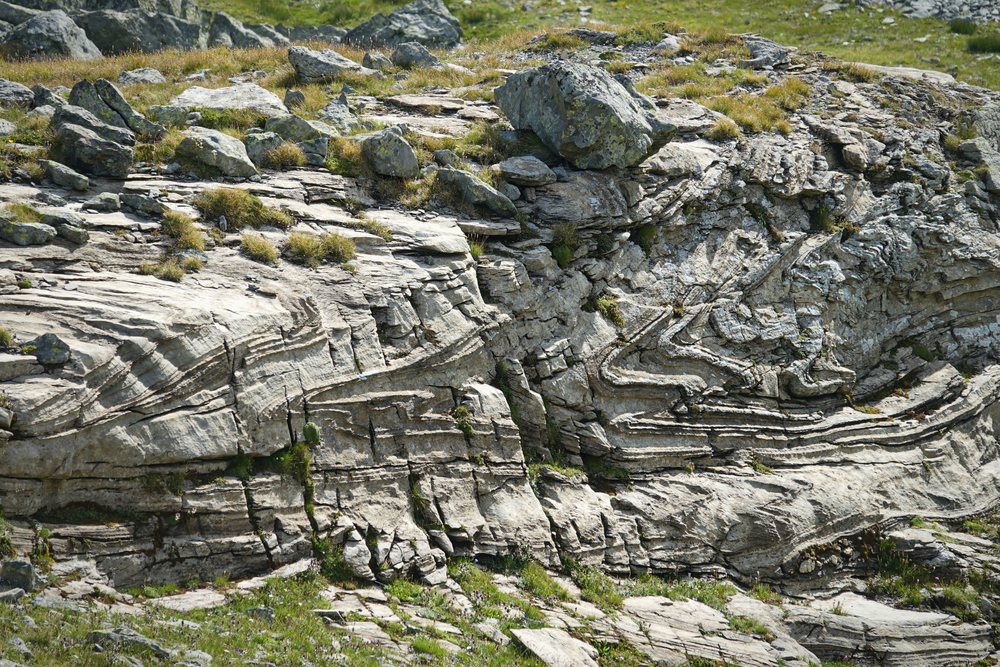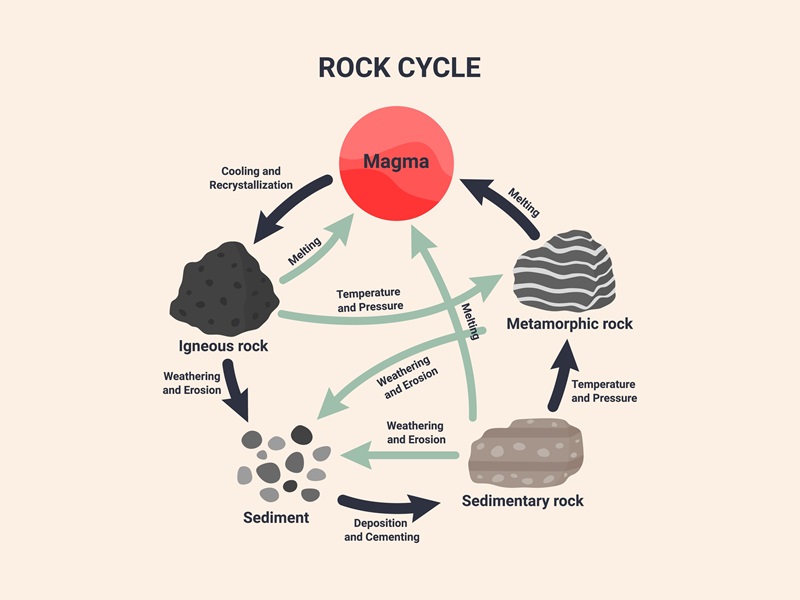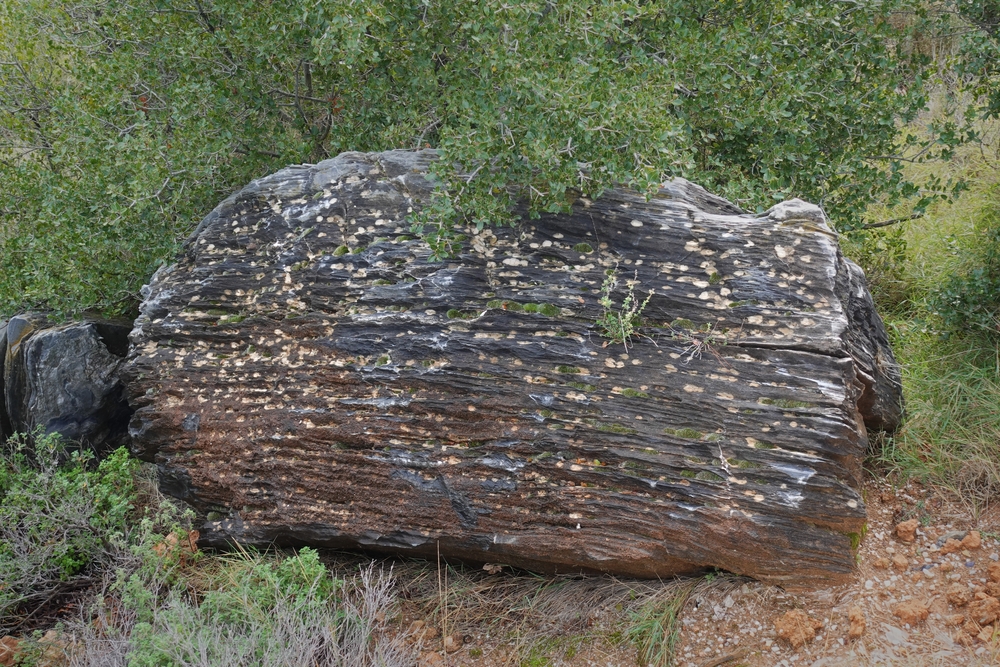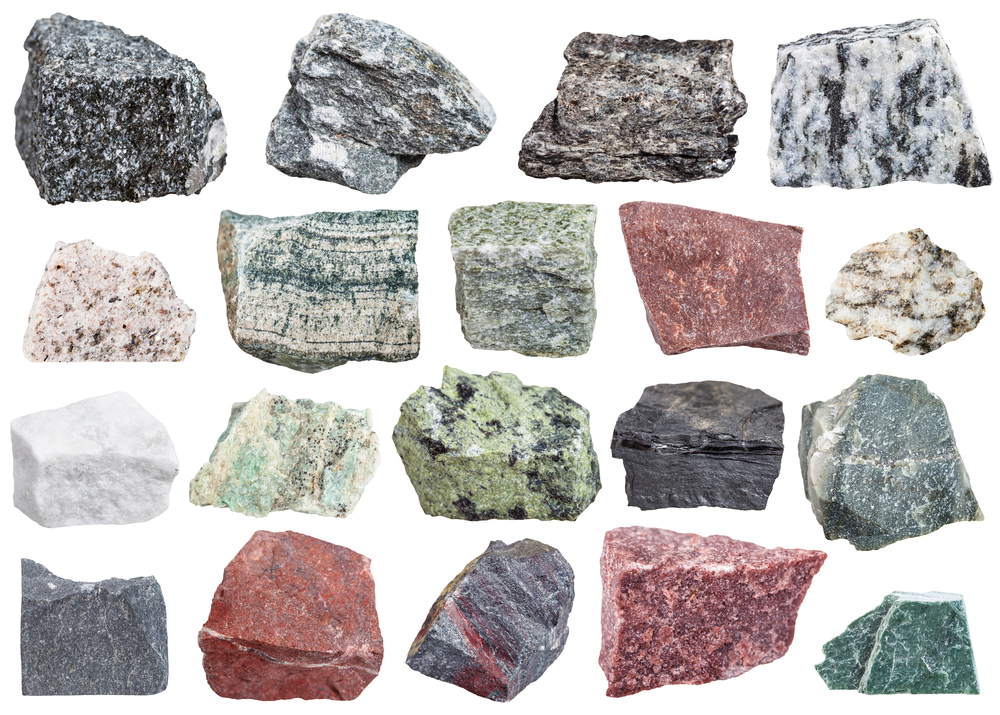
In the world of geology, we have three primary types of rocks to learn about. Metamorphic are, perhaps, the most complex of them and it can be a bit baffling to view them before someone breaks it down. It’s a fascinating world, one made of oddities like marble and gneiss.
So, let’s take a closer look at metamorphic rocks and how they are altered and then brought to the surface.
The Rock Life Cycle

It’s a bit odd to think of rocks as having an actual life cycle, but it’s important to understand how it happens. The oldest rocks are the igneous varieties, which consist of magma of varying compositions that has cooled as it reaches the surface of the Earth.
Over time, these rocks are exposed to the air, water, and other eroding forces that are on the surface of the Earth. The removed particles, or sediment, then pile on top of each other until we’re left with a sedimentary rock from the intense pressure of layer upon layer of sediment pressing them together.
Metamorphic rocks are igneous or sedimentary rocks, and sometimes even other metamorphic rocks, that have been subjected to intense heat and pressure after their formation. This can be the result of localized things like magma upswelling, or through tectonic events that cause incredible pressure and heat as the plates collide, slide, and often are uplifted by each other.
This complex formation process takes place over long geological periods. Geological time is different than how we normally reckon it. A “short time” in geological time is longer than all of human history, a long time is millions of years.
The important takeaway is this: metamorphic rock is bedrock that has been subjected to incredible heat and pressure for millions of years. This transforms the basic qualities of the stone and leaves behind evidence of past geological events.
Transforming Under Pressure
First, we need some perspective on pressures.
Pressure is measured in pascals. A pascal is equivalent to the amount of force that a 1kg object falling for one second produces. Just standing on the surface of the Earth we’re subject to 101,325 pascals of pressure, or roughly 101 kilopascals.
A million pascals is equal to about ten atmospheres. This unit is known as a megapascal.
At the depth where the wreck of the Titanic rests, the pressure is roughly 40.53 megapascal. This is enough weight to make it incompatible with human life (and most marine life for that matter) and requires carefully designed submersibles made of exotic materials just to withstand it. Failure to do so leads to the kinds of implosions measured in milliseconds.
The formation of metamorphic rocks begins at 300 megapascals. Don’t worry if your brain isn’t wrapping around it, it’s an absolutely insane amount of pressure compared to anything that we’re used to. Rock is pretty dense, after all, and
In addition, we need at least 200°C of temperature. That’s a much saner number, but when you consider it’s generated by the heat in the depths of the Earth it becomes a lot more obvious.
In other words, for the metamorphosis of a rock to occur the rock must be subjected to intense heat and pressure that’s beyond normal comprehension.
Mineralogical Changes
Changes to the minerals contained in the rocks can occur both from the intense pressure and heat, as well as chemical-laden fluids interacting with the rock while it’s in the plastic state that the metamorphic conditions produce in the rock.
Like all rocks, metamorphic bedrock is actually made of a large number of different minerals. At the right temperature and pressure, these can change chemical form. That’s regardless of the physical changes which will also occur.
The conditions themselves can produce two kinds of reactions.
Net-exchange reactions occur when a mineral breaks down due to the conditions. This can result in something like two minerals becoming two other minerals, or even just a hydrous mineral having the water removed from its structure. This latter change would result in a mineral turning into a different mineral plus water.
In general, these will involve a breakdown of the mineral in question before it renucleates and crystallizes again into a separate form.
There are also exchange reactions. In these cases, it’s generally a redistribution of ions between the two interacting minerals that results in a change to their solid solution structure. For instance, the interaction between almandine garnet and magnesium biotite will slowly change into pyrope garnet and iron biotite due to this exchange.
These reactions can be very complex, especially if you aren’t familiar with solid solutions but they’re only one part of the magic of metamorphic rock.
Structural Changes
Along with the changes in chemical composition, we also have changes that occur at a smaller level within the rock itself.
In the world of minerals, when we use the name of a mineral we’re referring to both the chemical structure of the individual molecules and the crystalline habit of the stone. In the case of an identical chemical structure but a different crystalline habit, the minerals are called polymorphs.
For instance, quartz (SiO₂) can metamorphose into stishovite or coesite. Both of these minerals are still pure SiO₂ but have different habits which make them distinct minerals of their own.
Foliation of Metamorphic Stones

One of the more drastic changes that occurs within metamorphosis is the texture change of the rock itself. This is how we end up with the alternating layers of minerals in rock like gneiss.
Foliation refers to the separating of different minerals into alternating layers and is a common feature of metamorphic stones. These layers aren’t necessarily easy to split apart, since not all of the minerals may be in “their” layer. In the aforementioned gneiss, for instance, the stone doesn’t really split along these lines.
In other cases, such as schist, the minerals may have planes of cleavage formed directly along these lines. This makes the stone much weaker in this direction and allows layers to be separated. This can also be a function of the minerals contained in the stone, such as the mica minerals that are common in schist-type rocks.
Foliation can occur in wavy, banded patterns rather than straight lines. This often occurs in subduction zones and other areas where there’s a lot of tectonic activity. While rock doesn’t have any chance of bending once brought to the surface, things are a little bit more plastic in the extreme conditions that form metamorphic stones.
Technically, metamorphic stones don’t actually melt, but instead are under such extreme conditions that they can deform in ways that we don’t normally associate with stone.
Not all metamorphic rock is foliated. Perhaps the most famous example of metamorphic stone is marble, which is known for its marbled patterns but actually isn’t foliated (ie: in separate layers) but instead has various levels of other minerals interspersed.
Examples of Metamorphic Stones

Metamorphic rocks are generally described by the type of stone they originated from. This is termed the “protolith” and describes the rock before it’s made it to its final form.
As noted above, the most famous metamorphic stone is marble. The protolith of marble is limestone, which consists primarily of carbonate minerals such as calcite and dolomite. Meanwhile, silica-rich sandstones will become quartzite.
Shale, on the other hand, results in slate after metamorphosis. Well, to a degree, it can also result in the rock known as phyllite if the metamorphosis is under higher pressure and temperatures.
There are varying degrees of metamorphism that show up in stones as well, which can define them. For instance, gneiss is a highly metamorphosed rock that’s often found on the edges of continental shelves. It can be separated into different categories based on its original composition, such as granitic gneiss or dioritic gneiss.
Since there are so many ways that they can be separated from each other, metamorphic rock is largely sorted into overarching “types” and then further differentiated based on chemical analysis of the resulting material.
Among the more common varieties are:
- Marble- Generally white, with some light banding. Marble’s lack of foliation and density has long made it a favored material for construction and artwork.
- Slate- Transformed shale, which has extensive foliation. Due to this and it’s attractive appearance it is often found as tiles both for walking on and on roofs.
- Gneiss- A highly foliated material with minimal cleavage. Due to where it is found (on the edges of tectonic areas) the material often has wavy lines instead of the straight ones associated with some other metamorphic rocks.
- Schist- Foliated in a way that it separates into very thin layers, and often named for its constituent minerals. Schist’s schistosity (or tendency to come apart in very fine layers) can make it a hazard and its rarely used for anything.
- Quartzite- A metamorphosed, fine-grained sandstone. Quartzite is sometimes used for decoration or art since it’s fine-grained and very compact. It can also display conchoidal fractures and was used for Stone Age tools where no better material was available.
There are a few other types, but the above cover the majority of these stones.
While the tectonic activity that brings them to the surface may seem rare, it’s important to remember that roughly 12% of the land mass on Earth has a bedrock created through metamorphism.
Other examples occur in much smaller areas. Stones like serpentinite and soapstone are both metamorphic rocks but occur in smaller amounts than those listed above.
Transformed Gem Material
Some gemstones may occur in metamorphic material at times. A good example is beryl (emerald, morganite, heliodor, etc.) which can be found in metamorphosed pegmatites. But that doesn’t necessarily make it a metamorphic mineral in and of itself.
Some gemstones, such as the garnet family, can be altered through metamorphism. We highlighted the example of pyrope and almandine garnet above. Since many gemstones are actually a solid solution, these examples are frequent.
Others are mainly associated with metamorphic rock, like spinel, but metamorphism isn’t required for their formation.
However, a rare few “gem” materials are actually metamorphosed rock. Jade, both nephrite and jadeite, is formed through metamorphism for example. Another shining example is lapis lazuli.
Diamonds, despite the enormous amount of pressure required for their formation, actually aren’t metamorphic. Instead, they’re considered igneous since they’re pulled from deep underground to the surface through such formations as kimberlite pipes.
- Online rock and mineral club for collectors of all levels!
- Find community with like-minded rock and mineral enthusiasts.
- Monthly Giveaways!
- Free Access to Entire Digital Library of Products (annual memberships)


